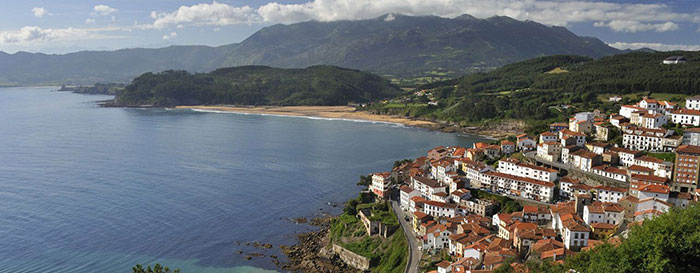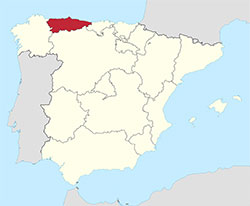Oviedo in Asturias

El Principado de Asturias (the Principality of Asturias) lies on the north coast of Spain bordering on the Cantabrian Sea and the provinces of Lugo, Cantabria and León. It covers an area of 10,603.57 km2 and has a population of 1,044,481 (2015). It is the most mountainous region of Spain with 35% of its surface being sloped at more than 50% and 65% at more than 30%. It was given the title Principality in 1388 when Juan I of Castilla decreed that the heir to the throne be titled Prince of Asturias.
The autonomous region of Asturias consists of only one province, and its capital city is Oviedo which lies in the centre of the province. However, Oviedo with its 220,567 (2016) inhabitants is not the most populated city in Asturias, this honour befalls Gijón on the north coast, which counts 273,422 (2016) souls. In the nature of the territory, the height of Oviedo varies between 55m and 714m above sea level.
The city is protected from the cold northern winds by the Monte Naranco, and to the south is the Sierra de Aramo mountain range where the Angliru mountain pass lies. Angliru’s claim to fame is that the grueling steep mountain road that leads up to it has been the venue of the final leg of the Vuelta a España bicycle race several times.
Oviedo boasts the titles ‘Very Noble, Very Loyal, Deserving, Undefeated, Heroic and Good’, which is included in its coat of arms, and which can also be found inscribed on a plaque on the façade of the town hall.
 Historically it has always been thought that the foundation of Oviedo dates back to the 8th century when the monks Máximo and Fromestano built a monastery dedicated to Saint Vincent on the hill called Oveto or Ovetao. King Fruela I visited the place and decided to erect a basilica for Saint Salvador, where his son, the future king Alfonso II ‘The Chaste,’ would be born in 760.
Historically it has always been thought that the foundation of Oviedo dates back to the 8th century when the monks Máximo and Fromestano built a monastery dedicated to Saint Vincent on the hill called Oveto or Ovetao. King Fruela I visited the place and decided to erect a basilica for Saint Salvador, where his son, the future king Alfonso II ‘The Chaste,’ would be born in 760.
Once Alfonso II ‘The Chaste’ became king, he moved the capital of the Kingdom of Asturias to Oviedo. It stayed there until it was moved to León as a result of the Reconquest .
During the middle ages the city’s importance declined and due to the isolation of its situation the development of Oviedo stagnated, but after fire destroyed a great part of the city in 1521 efforts were made to recuperate some of its former glory and various initiatives within commerce and culture managed to turn the tide and the population grew to over 8,000.
The industrialisation in the middle of the 19th century and the subsequent development of the service sector at the beginning of the 20th set Oviedo on the path of becoming the modern service minded city of today.
Oviedo’s climate is classified as oceanic with warm summers, cold winters and the rainfall distributed throughout the year, though heaviest in winter and spring. Because the city is quite far inland the temperatures fluctuate considerably between day and night, and in January, the coldest month, the average temperature between 1972 and 2000 was 8.0ºC, and in August, the hottest, it was 18.7.
Having been the capital of the Kingdom of Asturias the city boasts numerous Pre-Romanesque monuments built between 711 and 910. They are well preserved and looking at them takes you back through the centuries to a different age when religion played a dominating part in all aspects of society.
Some of the most outstanding examples of Pre-Romanesque architecture in Oviedo include the chapel Cámara Santo de Oviedo, the palace Santa María del Naranco which was converted into a church in the 12th century and the San Miguel de Lilo church.
Oviedo is a very green city with 2.2 million square meters of green zones, i.e. 10m2 per inhabitant and there are 10,000 trees planted in the city streets, many of which are pedestrian. The large park, Campo de San Francisco, covers 90,000m2 and is popularly known as El Campo among the natives of Oviedo.
Like most other large Spanish cities, Oviedo’s centre is a hubbub of life and boasts a wide range of designer boutiques, department stores, fast food outlets, bars and traditional restaurants as well as banks and hotels.
History
Asturias was inhabited, first by Homo erectus, then by Neanderthals. Since the Lower Paleolithic era, and during the Upper Paleolithic, Asturias was characterized by cave paintings in the eastern part of the area. In the Mesolithic period, a native culture developed, that of the Asturiense, and later, with the introduction of the Bronze Age, megaliths and tumuli were constructed. In the Iron Age, the territory came under the cultural influence of the Celts; the local Celtic peoples, known as the Astures, were composed of tribes such as the Luggones, the Pesicos, and others, who populated the entire area with castros (fortified hill-towns). Today the Astur Celtic influence persists in place names, such as those of rivers and mountains.
With the conquest of Asturias by the Romans under Augustus (29–19 BC), the region entered into recorded history. The Astures were subdued by the Romans but were never fully conquered. After several centuries without foreign presence, they enjoyed a brief revival during the Germanic invasions of the late 4th century AD, resisting Suevi and Visigoth raids throughout the 5th Century AD, ending with the Moorish invasion of Spain. However, as it had been for the Romans and Visigoths, the Moors did not find mountainous territory easy to conquer, and the lands along Spain's northern coast never fully became part of Islamic Spain. Rather, with the beginning of the Moorish conquest in the 8th century, this region became a refuge for Christian nobles, and in 722, a de facto independent kingdom was established, the Regnum Asturorum, which was to become the cradle of the incipient Reconquista (Reconquest).
In the 10th century, the Kingdom of Asturias gave way to the Kingdom of León, and during the Middle Ages the geographic isolation of the territory made historical references scarce. Through the rebellion of Henry II of Castile in the 14th century, the Principality of Asturias was established. The most famous proponents of independence were Gonzalo Peláez and Queen Urraca, who, while achieving significant victories, were ultimately defeated by Castilian troops. After its integration into the Kingdom of Spain, Asturias provided the Spanish court with high-ranking aristocrats and played an important role in the colonisation of America. Since 1388, the heir to the Castilian (later Spanish) throne has been styled Prince of Asturias. In the 16th century, the population reached 100,000 for the first time, and within another century that number would double due to the arrival of American corn.
In the 18th century, Asturias was one of the centres of the Spanish Enlightenment. The renowned Galician thinker Benito de Feijóo settled in the Benedictine Monastery of San Vicente de Oviedo. Gaspar Melchor de Jovellanos, a polymath and prominent reformer and politician of the late 18th century, was born in the seaside town of Gijón.
During the Napoleonic Wars, Asturias was the first Spanish province to rise up against the French following the abdication of King Ferdinand VII on 10 May 1808. Riots began in Oviedo and on 25 May the local government formally declared war on Napoleon with 18,000 men called to arms to resist invasion.
The Industrial Revolution came to Asturias after 1830 with the discovery and systematic exploitation of coal mines and iron factories at the mining basins of Nalón and Caudal. At the same time, there was significant migration to the Americas (especially Argentina, Uruguay, Puerto Rico, Cuba and Mexico); those who succeeded overseas often returned to their native land much wealthier. These entrepreneurs were known collectively as 'Indianos', for having visited and made their fortunes in the West Indies and beyond. The heritage of these wealthy families can still be seen in Asturias today: many large 'modernista' villas are dotted across the region, as well as cultural institutions such as free schools and public libraries.
Asturias played an important part in the events that led up to the Spanish Civil War. In October 1934 Asturian miners and other workers staged an armed uprising (see Revolution of Asturias) to oppose the coming to power of the right-wing CEDA party, which had obtained three ministerial posts in the centralist government of the Second Spanish Republic. For a month, a Popular Front Committee exercised control in southern Asturias, while local workers committees sprang up elsewhere in the region. A war committee dominated by anarcho-syndicalist supporters took power in Oviedo . Troops under the command of a then unknown general named Francisco Franco Bahamonde were brought from Spanish Morocco to suppress the revolt. Franco applied tactics normally reserved for overseas colonies, using troops of the Spanish Legion and Moroccan troops: ferocious oppression followed.
As a result, Asturias remained loyal to the republican government during the Spanish Civil War, and was the scene of an extraordinary defence in extreme terrain, the Battle of El Mazuco. With Franco eventually gaining control of all Spain, Asturias - traditionally linked to the Spanish Crown - was known merely as the "Province of Oviedo" from 1939 until Franco's death in 1975. The province's name was restored fully after the return of democracy to Spain, in 1977. In the 50s and 60s the industrial progress of Asturias continued with the constitution of national enterprises like Ensidesa and Hunosa, but the 80s was the decade of a dramatic industrial restructuring.
On 30 December 1981, Asturias became an autonomous community within the decentralised territorial structure established by the Constitution of 1978. Rafael Luis Fernández Álvarez, who had previously served as the President of the Regional Council since 1978, became the first President of the Principality of Asturias, upon the adoption of autonomy. The Asturian regional government holds comprehensive competencies in important areas such as health, education and protection of the environment.


